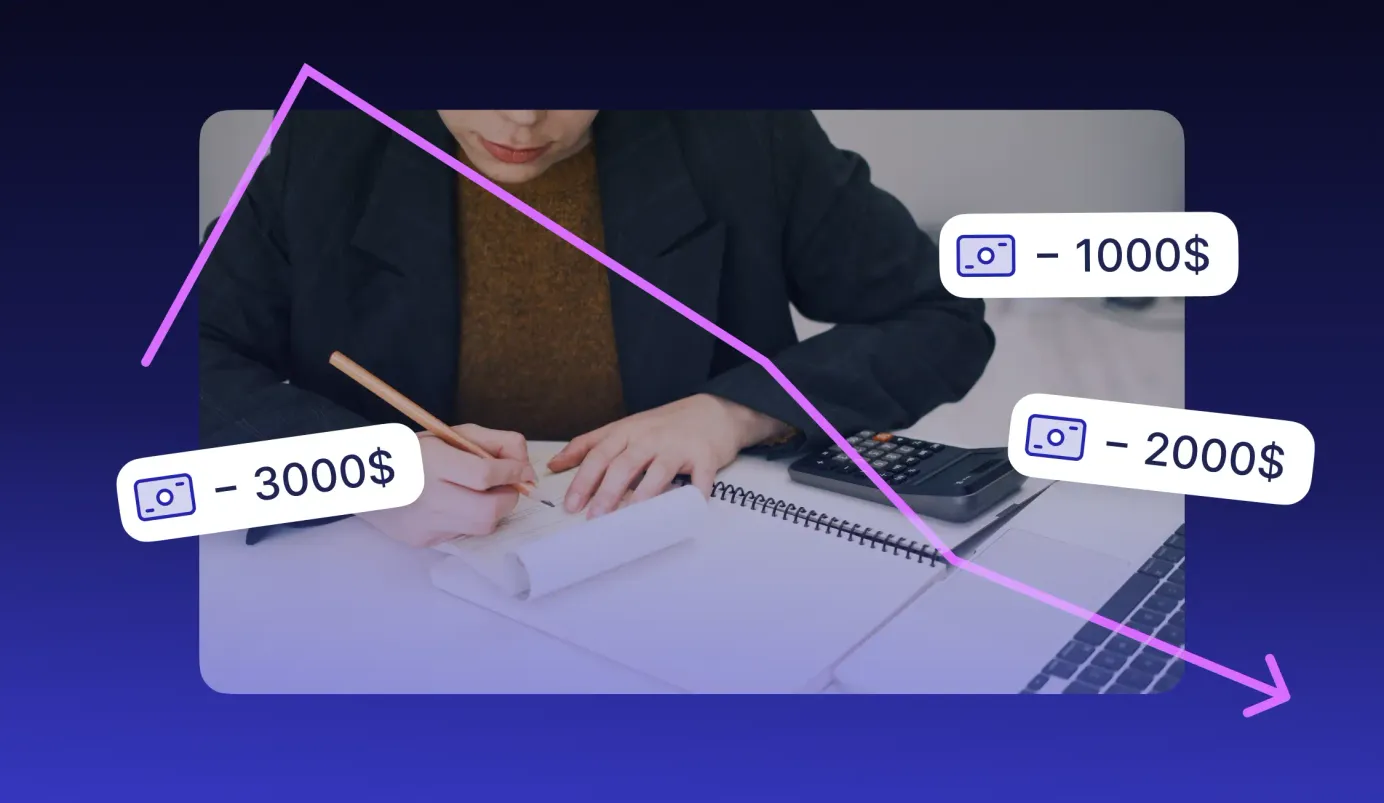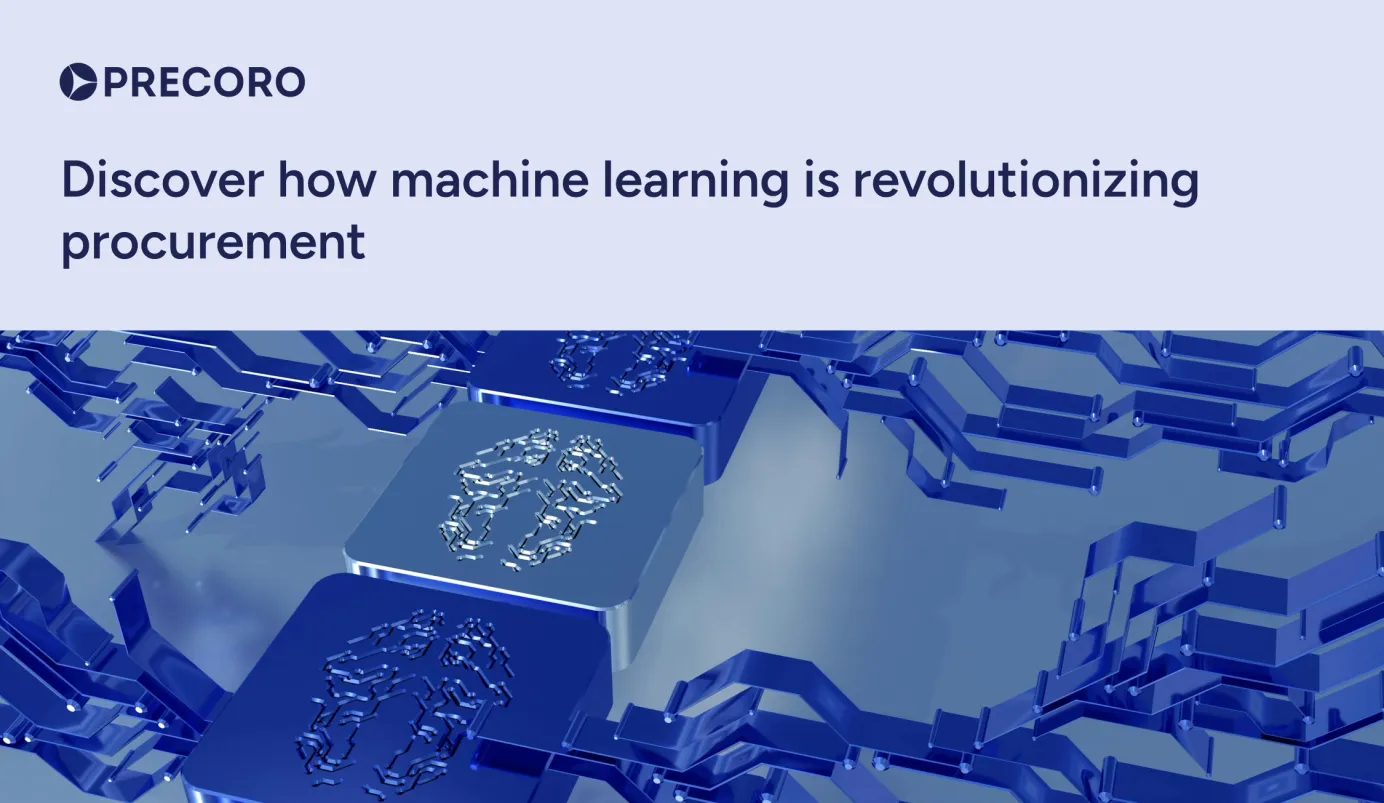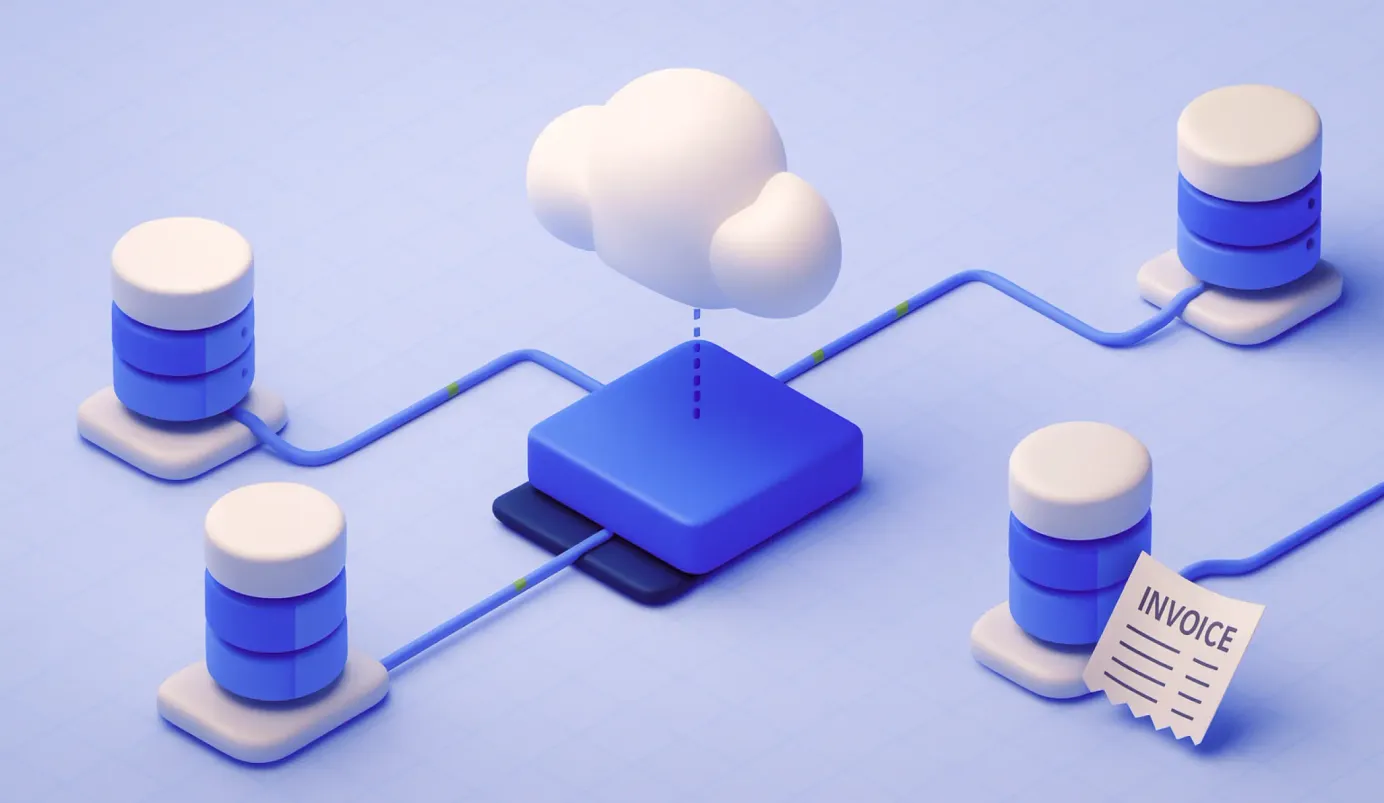
17 min read
End-to-End Procurement: Why Siloed Processes Fail
See how end-to-end procurement transforms siloed workflows into a connected and transparent purchasing process.
Picture this: an employee emails a supplier to place an order once they need something. The procurement team only finds out when the invoice shows up. The kicker: there’s no matching purchase order. Meanwhile, the warehouse tracks deliveries in a spreadsheet no one else can access. Each team is only aware of what’s happening at the level they control, but no one knows the entire picture.
If this scenario sounds familiar, it may be time to zoom out and look at the procurement process in its entirety. Procurement only works well when every step is connected. Yet in many companies, purchasing still happens in fragments: requests sent by email, approvals made in Slack, and invoices with no clear link to an order. What might seem convenient at first can actually slow down the entire purchasing cycle and hide off-contract purchases behind disjointed processes.
The answer is simple: step away from fragmented, outdated methods and turn to end-to-end procurement, where purchasing is treated as a single system, not a collection of standalone processes.
Here’s why an end-to-end approach is changing the way companies manage purchasing, and why it’s the key to running a modern, cost-efficient procurement function.
Read on to find out:
What is end-to-end procurement?
How end-to-end procurement outperforms fragmented procurement
Key stages of the end-to-end procurement process
End-to-end procurement services: What to outsource and what to keep in-house
How to transition to end-to-end procurement
Frequently asked questions about E2E procurement
How Precoro automates procurement end-to-end
What is end-to-end procurement?
End-to-end procurement is a comprehensive process of managing each step of the procurement lifecycle in a single, coordinated flow. Rather than keeping functions separate, every stage in the process builds on the one before it. Information and data are shared between all involved teams, so all parties have the necessary context for each purchase.
With this approach, you treat each stage of purchasing not as a separate task but as a gear in a single mechanism. If one doesn’t work properly, the entire machine falters and stops operating. The same applies to communication: if the team at the end of the chain isn’t aware of what happens at the start, they may not have enough information to complete their part of the process.
How end-to-end procurement outperforms fragmented procurement
End-to-end procurement encompasses a structured chain of interconnected processes that depend on one another. Companies that follow an end-to-end approach usually rely on a centralized purchasing solution, which allows them to store and manage all purchasing data in one place.
Fragmented procurement, by contrast, relies on a patchwork of systems, spreadsheets, and manual processes. There’s no single source of truth to follow, which means each team either goes to great lengths to get all information about the purchase or omits key details for the sake of urgency.
Each team handles its part of the process, but without a shared platform or real-time data sync, data gaps appear and updates are delayed. In fact, 79% of procurement teams don’t have a dedicated management software to track and manage purchasing. Information often moves slowly, and decisions at one stage don’t always align with what’s happening at the next.
Here are all the areas where fragmented procurement falls short and where an end-to-end approach makes all the difference.
- Unified process and visibility.
When every step aligns with the next, all teams access the same up-to-date information, so every approval and document status stays clear. No one needs to follow up on updates or wonder where an invoice came from. With a full picture of the entire procurement process, you automatically prevent blind spots that fragmented systems are prone to, such as duplicate purchases or inconsistent documentation.
- Faster cycle times.
When all teams actively collaborate to successfully complete the transaction, the process moves much faster. Centralized solutions can certainly help: with Precoro, companies managed to shorten their purchasing cycles by 50%.
If documents and workflows are kept in one place, you spend time actually doing the work rather than scrambling to find a matching PO or an approval lost in email chains. Instead, you can give access to everyone involved, set appropriate approval levels, and automatically route documents to approvers. What used to take weeks can often be done in days.
- Stronger compliance and control.
Fragmented procurement often depends on separate compliance rules for each process or on manual checks. Disconnected rules for invoices, requests, and POs create blind spots in spending and open the door to compliance risks.
End-to-end procurement helps apply established rules and approval limits across every stage of the process. Each purchase request, order, and invoice follows predefined policies automatically, without relying on manual checks. Approvers see the same compliance framework, so no document can move forward unless it meets company standards.
- Accurate data and reporting.
According to McKinsey, companies keep less than 70% of their spend data in one place. Teams often store documents and information in their own spreadsheets, folders, or systems that other employees can’t access. For example, if the warehouse team records deliveries but doesn’t notify accounts payable or share a goods received note, the AP team can’t release the payment until the delivery is confirmed.
Data centralization is a fundamental principle of end-to-end procurement. Consulting a single source of truth keeps everyone on the same page. Employees work with the same information, which means there’s less risk of duplicated or mismatched documents.
- Improved supplier relationships.
Scattered data, unclear ownership, and fragmented processes don’t just impact internal teams. It can also damage your external relationships with suppliers. Vendor partnerships flourish with consistent communication and feedback. When contracts are unclear or purchase orders aren’t properly tracked, you’ll run into misunderstandings and damage relationships.
Keeping all documents in one place helps build trust and transparency. Also, consider solutions that let suppliers collaborate directly with your team on procurement documents. For example, Precoro’s Supplier Portal enables vendors to submit their certificates, process purchase orders, update product catalogs, and even track invoice statuses.
- Better scalability.
As the company expands, fragmented processes become even riskier and harder to manage. The higher the purchase volume, the more any oversight will cost. You’ll have to make changes at each stage of the process to accommodate a new entity or a higher order count.
When every step follows the well-defined structure and can be clearly monitored in a single system, it’s easier to replicate processes across teams or new locations. You don’t have to rely on individuals to pass information between disconnected tools or departments.
- Better employee experience.
With end-to-end procurement, employees no longer struggle to figure out which form to use or whom to contact for approval. A connected workflow has an established policy that employees can follow. Or if you’re using a centralized solution, you can simplify intake with custom templates and required fields, so employees enter only the information you actually need to order.
The system isn’t riddled with dozens of confusing rules for each step. Instead, you have a structured, straightforward process that’s easy to understand and even easier to comply with.
Let’s compare how fragmented procurement stacks up against the end-to-end process.
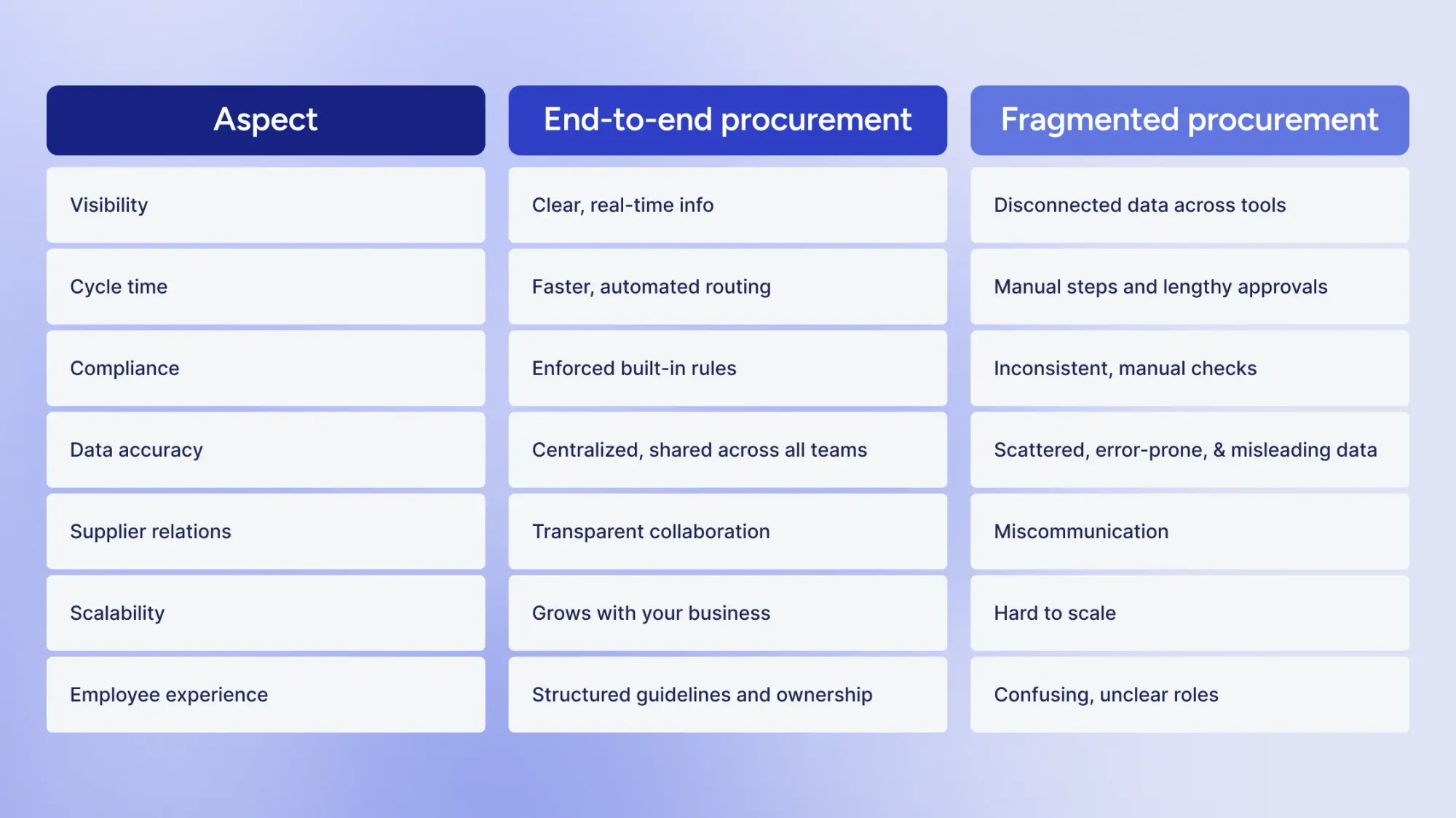
Fragmented processes may run just fine and get the job done. But the entire process can often feel disjointed and stilted: too many hoops to jump through, too many people to check in with, and too much information to verify. End-to-end procurement, on the other hand, organizes the purchasing process into a single, clear workflow that employees can follow while staying fully connected.
Key stages of the end-to-end procurement process
Just like with any other approach to procurement, the end-to-end procurement process follows a series of steps in the typical purchasing cycle. Each of them is simple: you figure out what’s needed, then move on to sourcing, requesting, ordering, delivery, and finally, payment. Let’s note what makes every stage different in end-to-end procurement.
1. Need identification
The process starts when a team or department recognizes that they must purchase specific goods or services to fulfill a certain need. During this stage, the company defines what to buy, why, and under which budget. Clear identification avoids unnecessary or duplicate purchases.
Within the end-to-end procurement process, you engage relevant stakeholders from multiple departments (e.g., procurement, operations, manufacturing, and AP) to make sure they a) are aware of the need and b) give input on what, how much, and whether it’s truly necessary.
2. Supplier selection and sourcing
Once the need is approved, the next step is to find the right supplier. Companies issue Requests for Proposal (RFPs) or Requests for Quotation (RFQs) to compare pricing, terms, and service quality across multiple vendors. Each supplier is evaluated on reliability, delivery timelines, compliance, and overall value, not just upfront cost. To speed up the process, you can create predefined templates for RFPs and RFQs and use a supplier management solution with centralization capabilities.
3. Contracting
Once the team approves the supplier, it’s time for both sides to agree on the terms of collaboration and sign the contract. This document outlines pricing, delivery schedules, payment terms, and service expectations. It protects your business and keeps both sides accountable. With procurement software, contract management becomes even easier. All agreements are stored in one central location, and automated reminders alert you when it’s time to renew or end a contract.
4. Purchase requisition
When a team needs to make a purchase, they submit a request with all the key details: requisition number, quantity, specifications, cost, and supplier (if known). The request is then sent to the right approvers based on budget, department, or project rules.
If done manually, this stage can be time-consuming. With end-to-end procurement, approvals are automated, tracked, and validated, so no document gets lost, delays are minimized, and compliance is maintained. Once approved, the purchase requisition can be turned into a purchase order.
5. Purchase order
A purchase order (PO) formally confirms what will be purchased, from whom, and at what price. The PO is sent to the supplier and becomes a binding document for both sides. End-to-end procurement providers like Precoro can generate purchase orders based on approved requisitions, or you can create them from scratch with ready-made templates.

6. Final approval and delivery
The supplier confirms the order and delivers the goods or services according to the agreed timeline. Internal teams track the order’s progress to ensure delivery meets quality, quantity, and deadline expectations. Once goods or services arrive, the receiving team checks them against the PO and flags any issues.
This step depends entirely on the previous stages: with a matching PO and supplier contract, the team can confirm if the vendor managed to provide everything requested and fulfill their obligations.
7. Invoice processing and 3-way matching
After delivery confirmation, the AP team receives the invoice from the supplier and matches it to the PO and receipt. They cross-check documents through 2-way (invoice and PO) or 3-way matching (invoice, PO, and receipt). Only verified invoices move to the payment stage.
8. Payment
After the invoice is finally approved, the AP team sends out payment to the supplier. The payment completes the transaction and is logged in both the procurement and accounting records. With an end-to-end approach, every step is documented—purchase request, purchase order, invoice, and receipt—so you have a complete, transparent trail before the final payment is made.
9. Reporting and performance analysis
In an end-to-end procurement setup, all purchasing data is stored in one system. Reports and dashboards make it easy to track spend trends, supplier performance, and compliance across the entire process. You can clearly see where money goes, where delays happen, and where you can save.
For instance, Precoro’s intuitive dashboards show real-time spending patterns, while the AI Assistant helps you dig deeper and highlights areas that need your attention. With custom and pre-set reports, you can analyze spend by supplier, category, document, or location.
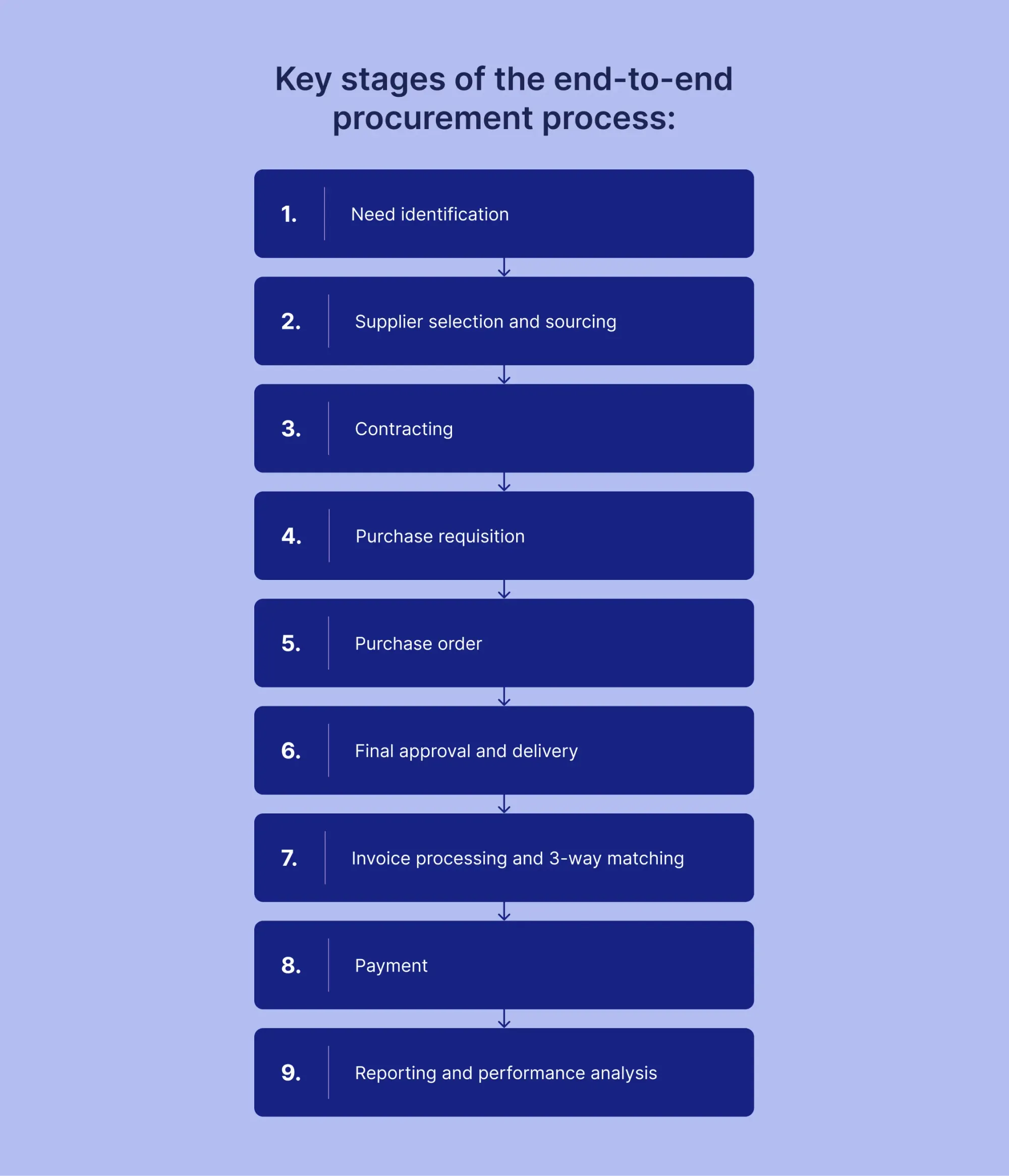
End-to-end procurement services: What to outsource and what to keep in-house
End-to-end procurement management takes time and expertise. Some companies prefer to handle the entire process internally; others hand parts (or all) of it to external providers. End-to-end procurement outsourcing isn’t going anywhere soon—68% of large enterprises have adopted some form of it. Both approaches work, and neither is worse than the other. It’s up to you to decide which tasks you’re comfortable outsourcing and which are better managed in-house.
In-house procurement means you control the entire process from start to finish. It’s ideal for strategic, critical tasks, such as managing key suppliers or sensitive data. However, the company carries a lot of responsibility and needs to invest significant time, budget, and labor to successfully handle all the functions in-house.
On the other hand, outsourced procurement relies on third-party specialists who handle specific functions such as purchase order processing, invoice management, or even entire sourcing operations. End-to-end procurement outsourcing can save time, reduce expenses, and help tap into external expertise you’ve previously had no access to. But it still needs hands-on management and doesn’t always offer the same flexibility as in-house control.
The real question is: which tasks should you keep in-house and which are better to outsource? First, identify the strategically important aspects of procurement. You’ll notice that not every step demands the same level of attention. Routine tasks like data entry are perfect for outsourcing with end-to-end procurement services. However, functions that rely on deep company knowledge and supplier relationships are best kept internal.
Consider end-to-end procurement outsourcing
The hours your team spends on repetitive, mindless paperwork or data analysis could be easily handled with automated end-to-end procurement services. Functions in the purchasing cycle suitable for outsourcing include:
- Purchase order processing. Creating and managing purchase orders is often one of the most time-consuming parts of procurement, but it’s not very strategic, just like any data entry. Companies can outsource this function to third-party providers or use an automated solution that handles PO creation with minimal internal input.
- Invoice management and 3-way matching. Matching invoices, purchase orders, and receipts can be standardized and automated. End-to-end procurement providers often rely on automation and AI to speed up the process. For example, Precoro uses Google AI-powered OCR to capture invoice data and generate a complete invoice, which can then be used in an automatic 3-way matching process—no manual work involved.
- Indirect spend management. Managing indirect spend, such as office supplies or IT subscriptions, can be messy and scattered because these purchases aren’t generally prioritized. External providers centralize purchasing, track expenses, and identify cost-saving opportunities in areas more prone to rogue spend, as long as the vendor partnership is still carefully managed by the internal team.
- Routine reporting and spend analysis. Data collection and formatting take time. End-to-end procurement providers can handle report generation, spend categorization, and basic analytics. Your internal team can then interpret these insights and act on them based on their strategic knowledge of the company and its objectives.
Keep in-house
Some responsibilities are too important to hand off. If something requires detailed internal knowledge or established long-term partnerships, then it’s best handled in-house. Examples include:
- Category strategy. Unless the outsourcing team thoroughly researches which categories are most critical to the company's goals, their input on category management might seem disconnected from your priorities. This level of knowledge is difficult for end-to-end procurement consultants to achieve, which means it’s best to keep it internal. Additionally, if the company assigned category owners as part of their category management strategy, it’s better to leave the strategic part to them.
- Contract management and risk assessment. Contracts define your company’s obligations and protections. Internal control here ensures compliance and alignment with corporate policies, both of which can be lost if completely handed over to external partners. They certainly can (and should) assist for the sake of additional expertise, but the final say should stay with your company.
- Sustainability and innovation initiatives. With ESG regulations getting more stringent year after year, companies make more of an effort to meet their CSR obligations. They turn to green sourcing, diversify their supplier networks, or apply stricter due diligence checks on vendors. Additionally, competition intensifies with each technological breakthrough and pushes businesses to innovate their products further. Both of these aspects impact company reputation and have to be directly aligned with general strategic objectives. The hybrid approach works best here: the internal teams handle the majority of planning, with external expertise brought in when needed.
- Supplier relationship management (SRM). Strong supplier partnerships can lead to better pricing, discounts, reliable delivery, and collaboration. While you can outsource vendor onboarding and RFP collection, handle long-term cooperation with suppliers internally. You can do that either with a dedicated vendor management team or your procurement team. What matters is consistent communication, which, in turn, builds trust and mutual rapport, something no end-to-end procurement consultant can replicate on your behalf.
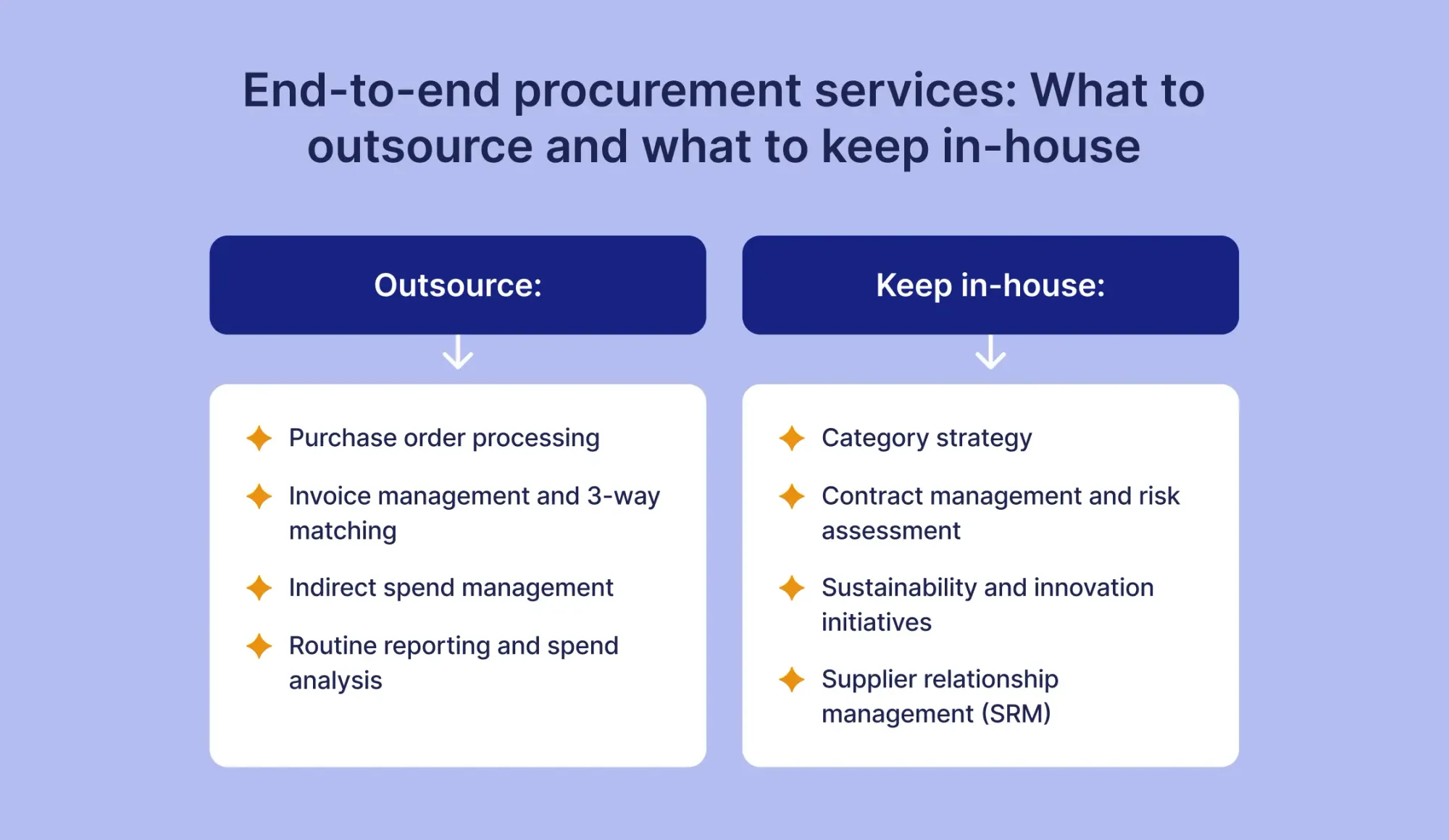
How to transition to end-to-end procurement
Transforming procurement from a set of isolated activities into an end-to-end process is challenging and full of obstacles. However, with the right approach and mindset, it’s definitely achievable. Here’s how to get there:
1. Map and align the entire process.
Outline your current procurement workflow, from requisition to payment. What’s your intake management process? What happens after a PO is approved? Identify gaps and potential data silos that cause miscommunication, such as unclear approval workflows for invoices or missing guidelines for budget overruns. Then, set shared goals for each team so everyone understands how their actions impact the next step.
2. Centralize data and documentation.
Use a single centralized system for all purchase orders, supplier details, contracts, and invoices. The market offers a myriad of procurement platforms and ERP systems designed for this purpose. Storing all purchasing data in one place prevents duplication and ensures decisions are based on the same up-to-date information.
3. Standardize policies and approval workflows.
Establish consistent purchasing rules, approval chains, and spend limits. Standardization keeps the process predictable and auditable, which is especially important when multiple departments or locations are involved. However, create separate guidelines for exceptions, such as urgent orders of critical supplies, or recurring issues like off-contract spend.
4. Automate wherever possible.
Procurement automation puts the theory into action. The structure and policies you laid out in the previous steps can be enforced and applied with automated solutions. For instance, you can generate ready-to-use purchase orders from approved requests or have the system send automatic alerts for contract renewals or budget overruns.
While automation speeds things up, it also connects the dots between each step. In procurement software, all related purchase documents are interlinked within the system and have a traceable path that you otherwise would have to track down manually.
5. Encourage communication and raise awareness.
A truly end-to-end process only works if everyone follows it. It would surprise you how many procurement mistakes happen due to employee confusion rather than broken processes. Train employees on established purchasing policies, share process updates, and define responsibilities and ownership from the start.
Encourage communication between all departments, so no team operates in isolation. If needed, bring in end-to-end procurement consulting services to take on manual and rule-based tasks and free up your team for more strategic objectives.
6. Track performance and improve.
Measure procurement KPIs, such as cycle time, cost savings, and compliance rates, and use those insights to refine your process. End-to-end procurement shouldn’t be a one-and-done task. On the contrary, as your company evolves and your supplier network grows, so should your purchasing policies.
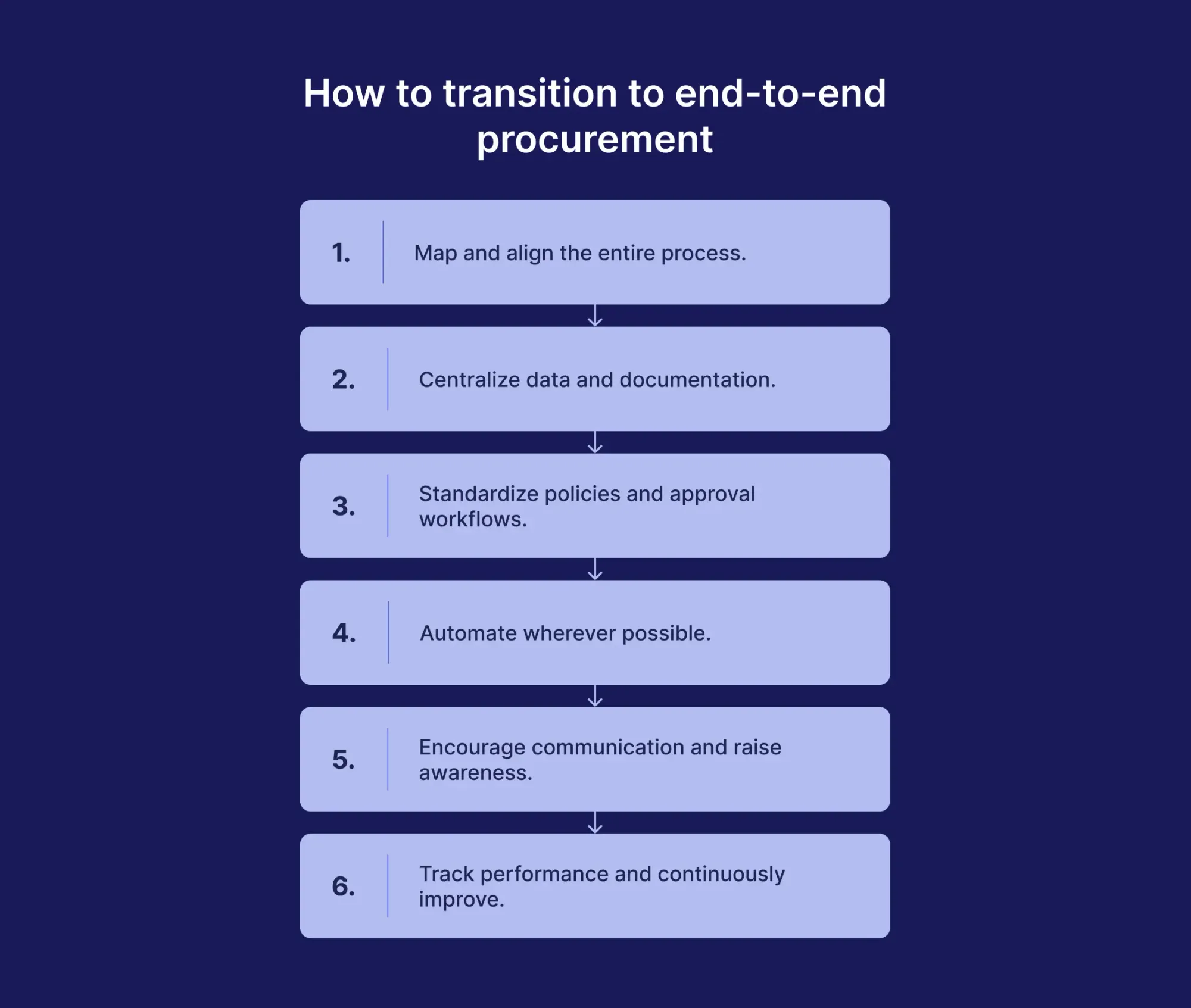
Frequently asked questions about E2E procurement
E2E, or end-to-end procurement, refers to the complete flow of activities from identifying a need to paying the supplier. It covers intake, sourcing, contracting, purchasing, delivery, invoicing, and reporting. Each step is connected within a single system, so data, approvals, and documentation stay consistent. The goal is full visibility and control over spend, supplier performance, and compliance.
An end-to-end process starts at the first request and only ends when all steps and checks are complete. In procurement, this practice means moving from a purchase request through approval, order, delivery, and payment with minimal data and communication gaps.
Both options have advantages. An in-house team gives the company more control over purchasing management, sensitive data, and strategy. Outsourcing offers faster access to expertise, automation, and round-the-clock support, which is especially useful for high transaction volumes or global operations. Many companies choose a hybrid approach: internal teams handle sourcing and strategy, while an outsourced provider manages day-to-day purchasing and repetitive tasks.
Fragmented procurement happens when departments or business units use separate tools or don’t have the same level of access to purchasing information. End-to-end procurement connects every stage into a single, visible process. Instead of separate systems for sourcing, invoicing, and payments, an E2E model typically relies on a single solution. All teams work with the same data, and every transaction has a clear audit trail.
How Precoro automates procurement end-to-end
Precoro connects every stage of the end-to-end procurement process into one cohesive system.
With purchase requisition management, employees can submit requests using predefined budgets and custom fields, so spend data is captured from the very beginning. Customizable approval workflows then route those requests automatically to the right decision-makers. Once approved, purchase orders can be generated automatically and linked directly to the company’s budgets.
Precoro’s supplier management keeps vendor data and contract agreements centralized, so all teams always work from the same source of truth. Budget control in the form of automatic overrun alerts and 3-way matching keeps spending transparent and payments accurate, while AI-powered invoice automation removes the manual work from accounts payable.
With advanced reporting and real-time dashboards, every transaction, approval, and supplier interaction becomes measurable. You can track spending patterns, identify bottlenecks, monitor budget usage, and improve team performance, all in one place.
And finally, Precoro’s AI assistant takes it even further. It helps teams instantly create purchase orders, review budgets, or look up supplier details, so you get quicker access to insights.


